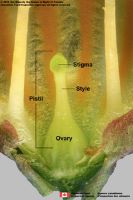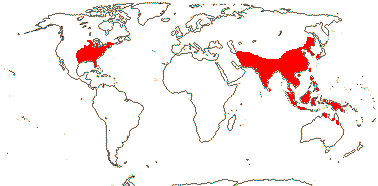Family name: Nelumbonaceae A. Richard
Synonym(s): none
Common name(s): lotus-lily family
*Number of genera/species: 1/3
List of genera records in GRIN-Global
Note, description below describes achenesachene:
a dry, indehiscent, one-seeded fruit, with seed attached to pericarp at a single point, derived from a single, superior, simple or compound, one-loculed ovary not infructescencesinfructescence:
not infructescencesinfructescence:
mature (fruiting) inflorescence
.
Fruit an acheneachene:
a dry, indehiscent, one-seeded fruit, with seed attached to pericarp at a single point, derived from a single, superior, simple or compound, one-loculed ovary (or infructescenceinfructescence:
(or infructescenceinfructescence:
mature (fruiting) inflorescence
of 12–40 achenesachene:
a dry, indehiscent, one-seeded fruit, with seed attached to pericarp at a single point, derived from a single, superior, simple or compound, one-loculed ovary embedded in sclerifiedsclerified:
embedded in sclerifiedsclerified:
texture—hardened
receptacle), 10–20 mm long, globoseglobose:
3D shape—more or less spherical , ovoidovoid:
, ovoidovoid:
3D shape—ovate , or oblongoblong:
, or oblongoblong:
2D shape—much longer than broad with nearly parallel sides, corners are rounded , tereteterete:
, tereteterete:
approximately circular in cross section; width and thickness approximately equal
 in transection, stigmastigma:
in transection, stigmastigma:
the portion of the pistil receptive to pollen persistent surrounded by circularcircular:
persistent surrounded by circularcircular:
(of embryo) linear embryo is curved into an "O" shape rim, pore visible near stigmastigma:
rim, pore visible near stigmastigma:
the portion of the pistil receptive to pollen , with one seed. Pericarppericarp:
, with one seed. Pericarppericarp:
fruit wall or fruit coat
brown, dulldull:
reflecting only a low proportion of incident light, with no apparent sheen , thick and hard, glabrousglabrous:
, thick and hard, glabrousglabrous:
without hairs
, smooth.
Seeds ovoidovoid:
3D shape—ovate , tereteterete:
, tereteterete:
approximately circular in cross section; width and thickness approximately equal
 in transection, glabrousglabrous:
in transection, glabrousglabrous:
without hairs
.
Embryo well developed, completely filling seed coat, foliatefoliate:
appearing leaf-like
, straight, with investinginvesting:
(of embryo) embryo is nearly or completely filling seed coat, straight, and axile and centric with spatulate cotyledons and covering the stalk for at least half its length; (of cotyledons) cotyledons spatulate and covering the stalk for at least half its length
cotyledons. Cotyledons large, fleshy, cream-colored, somewhat to significantly wider than hypocotyl-radicle, connate at margins forming cup around green plumule with several leaves.
Endosperm scanty, thin film.
| Fruit | |
| Type | acheneachene: a dry, indehiscent, one-seeded fruit, with seed attached to pericarp at a single point, derived from a single, superior, simple or compound, one-loculed ovary  |
| Size range | 10–20 mm long |
| Shape(s) | globoseglobose: 3D shape—more or less spherical  , ovoidovoid: , ovoidovoid:3D shape—ovate  , oblongoblong: , oblongoblong:2D shape—much longer than broad with nearly parallel sides, corners are rounded  |
| Texture | thick, hard |
| Surface relief | smooth |
| Color(s) | brown |
| Unique features | Brown, thick-walled achenesachene: a dry, indehiscent, one-seeded fruit, with seed attached to pericarp at a single point, derived from a single, superior, simple or compound, one-loculed ovary  with large embryos, which have fleshy, cream-colored cotyledons cupped around a green plumule with leaves. AchenesAchene: with large embryos, which have fleshy, cream-colored cotyledons cupped around a green plumule with leaves. AchenesAchene:a dry, indehiscent, one-seeded fruit, with seed attached to pericarp at a single point, derived from a single, superior, simple or compound, one-loculed ovary  may be embedded in a dry, sclerifiedsclerified: may be embedded in a dry, sclerifiedsclerified:texture—hardened receptacle. |
| Other | |
| Embryo | well developed, completely filling seed coat, foliatefoliate: appearing leaf-like , with investinginvesting: (of embryo) embryo is nearly or completely filling seed coat, straight, and axile and centric with spatulate cotyledons and covering the stalk for at least half its length; (of cotyledons) cotyledons spatulate and covering the stalk for at least half its length cotyledons, straight. Cotyledons large, fleshy, connate at margins forming cup around green plumule. |
| Nutritive tissue | endosperm scanty, thin film |

Distribution map courtesy of Angiosperm Phylogeny Website.
Flora of North America Editorial Committee 1993+Flora of North America Editorial Committee 1993+:
Flora of North America Editorial Committee, eds. 1993+. Flora of North America North of Mexico [Online]. 22+ vols. Flora of North America Association, New York and Oxford. Accessed January-March 2024. URL: http://beta.floranorthamerica.org.; Kirkbride et al. 2006Kirkbride et al. 2006:
Kirkbride JH, Jr, Gunn CR, and Dallwitz MJ. 2006. Family guide for fruits and seeds, vers. 1.0. Accessed September 2020-January 2022. URL: https://nt.ars-grin.gov/seedsfruits/keys/frsdfam/index.cfm .; Kubitzki et al. 1990+Kubitzki et al. 1990+:
Kubitzki K et al., eds. 1990+. The families and genera of vascular plants. 7+ vols. Berlin etc.; Takhtajan 2009Takhtajan 2009:
Takhtajan A. 2009. Flowering plants: Second edition. Springer Nature, Switzerland. 871 pp.
*The number of genera and species is based on Christenhusz and Byng 2016Christenhusz and Byng 2016:
Christenhusz MJM and Byng JW. 2016. The number of known plant species in the world and its annual increase. Phytotaxa 261 (3): 201-217. https://doi.org/10.11646/phytotaxa.261.3.1, which may differ from the number of genera in GRIN-Global.